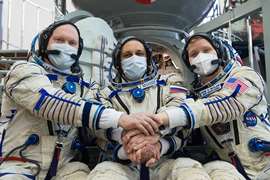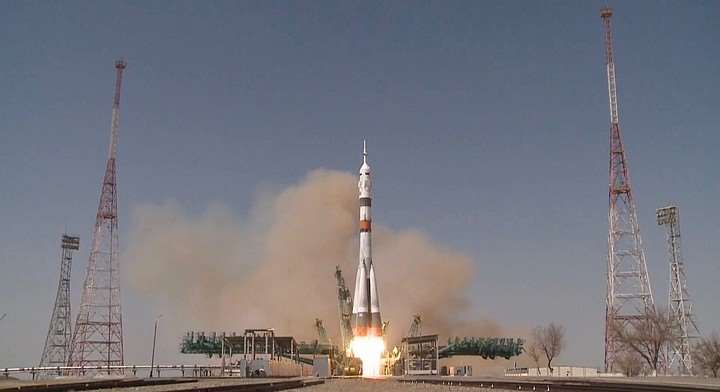
On April 9, the spacecraft Soyuz MS-18 Yu. A. Gagarin, named after cosmonaut No. 1, launched from the Baikonur cosmodrome – one of these days we will celebrate the anniversary of the legendary flight. A crew of three is on board. Together with Oleg Novitsky and Peter Dubrov, NASA astronaut Mark Vande Hai is leaving for the ISS. This company will have an incredibly rich and interesting flight program.
But first, let's answer the question: why was the American astronaut on the crew? After all, initially the company to Novitsky and Dubrov was supposed to be our Sergey Korsakov. And with the advent of the Crew Dragon manned spacecraft, the Americans finally had their own vehicle for delivering astronauts into orbit. Why do we take “fellow travelers” and drop our own?
There are two main reasons. First, there is no room for the third Russian cosmonaut on the ISS now. The fact is that when the crew was being formed, it was assumed that the new Russian multifunctional laboratory module “Science” (MLM) would already be docked to the ISS – there was just equipped a cabin for the third cosmonaut.
MLM was supposed to be launched in December 2020, but the launch was postponed and, most likely, the Nauka module will be launched into orbit in July this year. Secondly, the Americans are not doing well with the preparation of the Crew Dragon ships, which are supposed to change crews in orbit. And a situation could arise when they do not have time to launch the next “shuttle” in time – then not a single American will be on the ISS for some time. So they turned to us for help.
Now about the unique flight program.
1. Elimination of emergency cracks
Novitsky and Dubrov will tackle the problem, which, thanks to the hype in the media, seems to be the # 1 topic. In other words, they will begin to eliminate cracks in the Russian part of the ISS, through which the station loses its atmosphere. These leaks are small: initially, air losses were estimated at about 1 cubic meter per day. This is not catastrophic, given that the total air volume at the station is more than 1040 cubic meters, and there are large reserves of oxygen on board. After the active crew repaired two cracks, the volume of daily losses was reduced to 0.4 cubic meters. This means that there are still cracks, but they could not be found. The Soyuz MS-18 crew is carrying a new leak detector for these purposes. He will help to detect the leak and eliminate it.
2. Docking and connection of the new module “Science”
Apparently, this particular crew will have to receive the new multifunctional laboratory module “Science” in orbit. Its launch, as I wrote above, is scheduled for the summer. The development of the module began 25 years ago. With its launch, the total volume of the Russian segment of the ISS will double. Now it is about 70 cubic meters. MLM “Science” is a real colossus weighing 21 tons. Now we will have a third separate cabin for an astronaut (protected from radiation by a 10-mm aluminum plate), a second toilet, and, of course, a bunch of all kinds of scientific equipment. MLM has 30 universal workplaces for scientific studies. The subject of special pride is the EPA manipulator. A robot weighing 1800 kilograms is attached to the outer surface of the station and is capable not only of moving loads up to 8 tons, but also independently “walking” around the ISS.
There are 4 points on the surface of the station where the manipulator can move and set itself in a new place. This “hand of God” is designed to reduce the number of costly space walks. Many station maintenance operations and a number of scientific experiments can be carried out without leaving the ISS.
3. The first ever filming in space
The idea to shoot a movie in space came to the heads of the First Channel. Roscosmos supported it as a popular science project. Therefore, in October, an actress and a director will most likely go to the ISS on the Soyuz-19 spacecraft together with Anton Shkaplerov. Klim Shipenko will fly as a director, behind whose shoulders the shooting of such epic films as “Kholop”, “Salyut-7” and “Text”. The actress is still being chosen and the chances to star in a historical film are the second pilot of the Boeing 737 Anna Andrianova, parachutist Irina Buzina (155 jumps), captain of the Airborne Forces Anastasia Makarenko and master of sports in underwater wrestling Ekaterina Milovanova. Rumor has it that Svetlana Khodchenkova may also go to the ISS. However, Oleg Novitsky and Peter Dubrov will also take part in the filming. On the ground, they already communicated with the film crew, rehearsed scenes, memorized the text.

4. Preparing a Mars flight
If the movie project takes place and the movie stars fly to the ISS in October, then Petr Dubrov and Mark Vanda Hai will have to stay in orbit. Their places in the landing Soyuz-18 will be taken by an actress and director who will return to Earth under the supervision of Oleg Novitsky. And Peter and Mark will wait for the next Soyuz, which will arrive at the ISS no earlier than March 2022. Thus, their business trip will last a whole year. And this option suits NASA.
The fact is that the Americans are seriously preparing for a manned expedition to Mars and want to collect as much information as possible about how a long stay in space affects the human body. Six years ago, the first year-long flight to the ISS took place, it was performed by Scott Kelly and our Mikhail Kornienko. And on Earth, Scott's twin brother, Mark Kelly, remained as a “test sample”. However, NASA experts would like to have experience of at least 10 annual flights under their belt before being thrown to Mars (a round trip expedition to Mars will take more than 500 days). Therefore, the experience of a year-long Robinsonade in the orbit of Peter and Mark will very well fall into the treasury of the upcoming Martian expedition.

